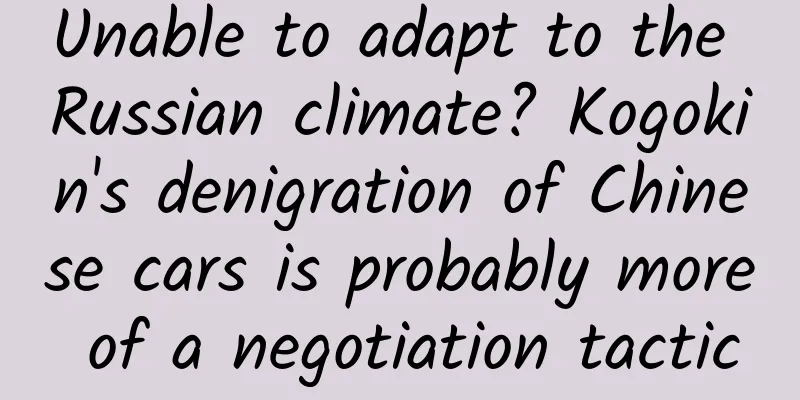Unable to adapt to the Russian climate? Kogokin's denigration of Chinese cars is probably more of a negotiation tactic

|
There is a joke on the Chinese Internet: The thinnest books in the world are "British Recipes", "American History", "German Jokes", "Italian War Heroes" and "History of the Development of Russian Civilian Industry". From the Soviet era to the present, Russia's civilian industry has been world-renowned for its poor performance. Ten years ago, Gao Xiaosong asked in his program: Have you ever seen Russian car brands in China? Some people in Russia are not convinced by this. Recently, at a parliamentary hearing of the Russian Federation Council's Automotive Industry Development Committee, Kamaz General Manager Kogokin criticized Chinese cars. He believed that Chinese manufacturers did not conduct joint car tests with Russian partners and might not be able to adapt to the Russian environment. He also poured cold water on those who bought parallel imported Chinese cars, believing that these cars would have quality problems. The Kamaz company is no small player. Kamaz, Russia's largest truck manufacturer, not only produces various types of civilian trucks, but also supplies armored vehicles and heavy trucks to the Russian military. A simple analogy shows that its position in the Russian automobile market is roughly equivalent to that of China's Jiefang or Sinotruk. As the general manager of Kamaz, Kogokin is a prominent figure in the Russian automotive industry, but his comments on Chinese cars do seem a bit unfair. China's automobile industry has developed to the point where it has become the world's largest exporter. No matter how powerful Kamaz is in Russia, it is only in Russia after all. What technical or market capital does it have to look down on Chinese cars? As the leader of Russian truck companies, Kamaz has relied on technical support from Western companies such as Mercedes-Benz and Liebherr in the past decade or so, and does not have much of its own. In 2008, Mercedes-Benz acquired a 15% stake in Kamaz, and many of its trucks have been jointly built with Mercedes-Benz and Liebherr. In contrast, China's domestic truck companies have basically gotten rid of their dependence on foreign technology. Interestingly, Kamaz also uses a large number of core components from China. Take the K5 family, the current main model of Kamaz, for example. Its axles are made by China's Hande 15-ton axles, and there are also Chinese components in other vehicle systems. GAZ, another large-scale automobile company in Russia, has its light commercial vehicle gearboxes and engines all from China. In 2022, GAZ invested 4.5 billion rubles to develop an engine called GAZ G21A, which is actually a technology application of China's Foton Motor. Other small and medium-sized companies are even more dependent on China's core components. Jianghuai Automobile, which can only be regarded as the second echelon in China, plays an important role in the Russian market. There is a famous car brand in Russia called Moskvich, which was founded in 1930 and was once the leader of Russia's civilian automobile industry. Starting from 2022, Moskvich began to launch the Moskvich 3 compact crossover and the Moskvich 3e electric car. Both cars use core technologies provided by China's JAC Motors. Kamaz is an important participant in this cooperation project. As the general manager, Kogokin should understand the strengths and weaknesses of the Chinese and Russian automobile industries. As for his claim that "Chinese cars are not suitable for the local environment and have poor quality", it is even more nonsense. Anyone who knows the Chinese automobile industry knows that the technical level of China's mainstream manufacturers has been rapidly improved. The "Russian road conditions" that Kogokin pointed out, such as extremely cold climates and muddy roads, are no problem for Chinese manufacturers. They will take these things into consideration when designing. China has a vast territory, and the climate conditions in the northeast are not much better than those in Russia's Far East, but Chinese-made trucks can run freely here. Kogokin's speculation and denial about Chinese cars only make people feel that he actually has something else to say. As for the reputation of Chinese cars in Russia, it is not up to Kogokin to decide; it is up to Russian consumers to decide. Chinese automakers such as Geely and Chery have been deeply involved in the Russian market for many years. After the outbreak of the Russia-Ukraine conflict, the market share of Chinese auto brands in Russia has expanded dramatically, reaching 16.9% in May 2022 and soaring to 49% in 2023. In June 2024, Russia sold 124,000 passenger cars, of which 76,000 were Chinese brands, accounting for nearly two-thirds. The Chinese brand with the largest share in the Russian market is Haval, with a market share of 12.2%. Haval First Love, which has been discontinued in the Chinese market for two years, ranked among the top three in the Russian car sales list in June. Car models that have been eliminated in China have become popular in Russia. Judging from this performance, the gap between the Russian and Chinese automobile industries is so large that it cannot be measured with a telescope. As for parallel imported cars, Kogokin's views are also quite outrageous. Why do parallel imported cars appear? Isn’t it because Chinese automobile products have strong performance and are highly recognized by Russian consumers, while Chinese cars are in short supply in the Russian market, so they are imported through this channel? The market is dominated by Chinese brands. They do not have core technologies and cannot find partners. Many brands rely on China's core technologies to survive. The current situation of the Russian automobile industry is roughly equivalent to the situation when China's civilian automobile industry just started more than 20 years ago. Under such circumstances, it is really incredible that Kogokin, as a leading figure in the Russian automobile industry, still has the time to mock Chinese cars. However, there is another possibility for Kogokin's statement, which is that he deliberately exaggerates or even fabricates the shortcomings of Chinese cars in order to increase his bargaining chips in negotiations with Chinese car manufacturers. To put it bluntly, it is just a bargaining tactic. Judging from the current situation, it is unlikely that the Russian automotive industry will obtain technical support from Western countries. As a large country with a population of over 100 million, Russia's automotive industry cannot fail to develop, and the only country that can provide technical guidance to Russia is Chinese manufacturers. If nothing unexpected happens, Russian auto companies such as Kamaz will become more and more dependent on Chinese manufacturers in the future, and they may seek various cooperation. Under the current conditions, Russian auto companies do not have much bargaining power with Chinese partners. Kogokin's questioning of Chinese cars is probably intended to lower the price in negotiations. One of the thinnest books in the world is "History of the Development of Russian Civilian Industry". Although it is a joke, it is an indisputable fact that Russia's automobile industry has always been weak. In fact, there is nothing wrong with the cooperation between the Russian automobile industry and Chinese automobile manufacturers, and Chinese manufacturers are also happy to provide help. But the prerequisite is that Russia needs to open its eyes to the world, put itself in the right position, and admit its shortcomings and deficiencies, just like China humbly learned from Volkswagen, Toyota and other companies in the past. Always cooperating with the mentality of a big brother will definitely not have any positive effect on the cooperation itself. Of course, if Kogokin's remarks are just an attempt to lower prices by belittling Chinese cars, then it doesn't matter. No matter how skilled one is in business negotiation, it will not help to bridge the real technological gap. As a winner of Toutiao's Qingyun Plan and Baijiahao's Bai+ Plan, the 2019 Baidu Digital Author of the Year, the Baijiahao's Most Popular Author in the Technology Field, the 2019 Sogou Technology and Culture Author, and the 2021 Baijiahao Quarterly Influential Creator, he has won many awards, including the 2013 Sohu Best Industry Media Person, the 2015 China New Media Entrepreneurship Competition Beijing Third Place, the 2015 Guangmang Experience Award, the 2015 China New Media Entrepreneurship Competition Finals Third Place, and the 2018 Baidu Dynamic Annual Powerful Celebrity. |
<<: You must pay attention to these issues when upgrading to Windows 10
>>: BMW and Mercedes-Benz luxury car sales generally fell sharply in the first five months of 2024
Recommend
Can breaking bones really increase height? It's not that simple
Growing taller is a beautiful wish of many friend...
Find out! Grass carp originated in western China 33 million years ago
Grass carp is one of the four major freshwater ca...
Awesome! A Complete Self-Study Guide for Designers
[[142226]] This article is translated from Quora,...
With its performance plummeting, will Nikon become the next Kodak?
In the 1970s, American imaging giant Kodak invente...
The operating system closest to the official version! Summary of the last beta version of Android 12
[[423267]] From the first developer preview versi...
Smartphones are updated very quickly, so why does the recording function still exist?
For users, mobile phone updates undoubtedly repre...
Android watches are better than Apple watches! Read these 9 points if you don’t believe me
The latest market research data shows that Apple ...
What is crawl frequency? Under what circumstances can the crawl frequency cap be adjusted?
Crawl frequency refers to the total number of tim...
Why do pigeons always bow their heads with each step when they walk? Won't they feel dizzy?
Review expert: Ran Hao, a well-known popular scie...
WeChat has updated its latest version, with 6 new features, each of which is what you have been waiting for.
[[411880]] 1. WeChat incoming call notification t...
Don’t be angry or anxious! These skin problems that damage your appearance are all psychologically related.
A suggestion for everyone Be happy now! Image sou...
Science Time Machine | The “birth” of batteries can actually be thanked to frogs?
One of the important qualities of scientists is t...
Can you learn Pinduoduo-style fission?
The concept of fission actually existed a long ti...
Which chip has better performance? Qualcomm Snapdragon 801 vs HiSilicon 920 chip
Looking back at the first half of 2014, the domes...
DeepLink page jump technology between mobile applications
Introduction to DeepLink DeepLink is a technology...









